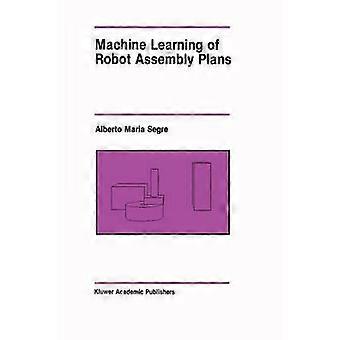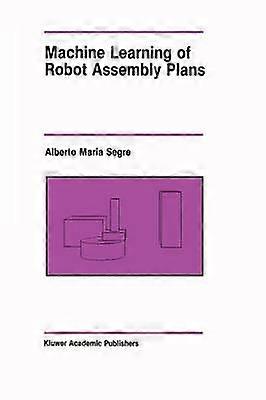Description
1 Introduction. - 1. 1. Machine Learning. - 1. 2. Robotics. - 1. 3. About the Book. - 2 Scenario. - 2. 1. Preliminaries. - 2. 2. Specifying the Problem. - 2. 3. Attempting to Solve the Problem. - 2. 4. Observing the Expert's Plan. - 2. 5. Generalizing the Solution. - 2. 6. Solving the Same Problem After Learning. - 2. 7. Solving Similar Problems After Learning. - 3 Explanation-Based Learning. - 3. 1. Similarity-Based Learning. - 3. 2. Learning-Apprentice Systems. - 3. 3. Explanation-Based Learning. - 3. 4. A Prototypical EBL System. - 3. 5. Issues for EBL Systems. - 4 The Arms World. - 4. 1. Characterizing the Robot World. - 4. 2. Simulating the Robot World. - 5 Learning And Problem Solving. - 5. 1. Knowledge Representation. - 5. 2. The Performance Element. - 5. 3. The Learning Element. - 6 The Arms Implementation. - 6. 1. A Note About the Implementation Language. - 6. 2. Optimization Tools. - 6. 3. Implementing the Solid Modeler. - 6. 4. Implementing the Graphics Subsystem. - 6. 5. Implementing the Schema System. - 6. 6. Implementing the Top Level. - 7 Scenario Revisited. - 7. 1. Attempting to Solve the Problem. - 7. 2. Observing the Expert's Plan. - 7. 3. Verifying the Solution. - 7. 4. Generalizing the Solution. - 7. 5. Solving the Same Problem After Learning. - 7. 6. Solving Similar Problems After Learning. - 7. 7. Observing Similar Problems After Learning. - 8 Summary And Future Work. - 8. 1. Relation to Other Work. - 8. 2. Extensibility of ARMS. - 8. 3. Future Research Directions. - 8. 4. Conclusions. - Appendix A Solid Modeling Systems. - Appendix B Schema Semantics. - Appendix C A Simpler Example. - C. 1. Describing the Initial State. - C. 2. Attempting to Solve the Problem. - C. 3. Observing the Expert's Plan. - C. 4. Verifying the Solution. - C. 5. Generalizing the Solution. - C. 6. Solving the Same Problem After Learning. - C. 7. Solving SimilarProblems After Learning. - C. 8. Observing Similar Problems After Learning. - Appendix D A More Complex Example. - D. 1. Describing the Initial State. - D. 2. Attempting to Solve the Problem. - D. 3. Observing the Expert's Plan. - D. 4. Verifying the Solution. - D. 5. Generalizing the Solution. - D. 5. 1. A More General New Schema. - D. 5. 2. A More Operational New Schema. - D. 6. Solving the Same Problem After Learning. - D. 7. Solving Similar Problems After Learning. - Appendix E Performance Considerations. - E. 1. Learning Episode 1. - E. 2. Problem-Solving Episode 1. - E. 3. Problem-Solving Episode 2. - E. 4. Problem-Solving Episode 3. - E. 5. Problem-Solving Episode 4. - E. 6. Learning Episode 2. - E. 7. Learning Episode 3. - E. 8. Problem-Solving Episode 5. - E. 9. Problem-Solving Episode 6. - Appendix F Built-in Schemata. - F. 1. State Schemata. - F. 1. 1. Joint Schemata. - F. 1. 2. Degree of Freedom Schemata. - F. 1. 3. Constraint Schemata. - F. 2. Operator Schemata. - F. 2. 1. Primitive Operator Schemata. - References. Language: English
-
Marque:
Unbranded
-
Catégorie:
Informatique et Internet
-
Nombre de pages:
234
-
Date de publication:
2011/10/05
-
Editeur / Label:
Springer
-
Format:
Paperback
-
Langue:
English
-
Artiste:
Alberto Maria Segre
-
Identifiant Fruugo:
337913974-741573425
-
ISBN:
9781461289548
Livraison & retours
Expédition dans un délai de 4 jours
Expédition de Royaume-Uni.
Nous mettons tout en œuvre pour que les produits que vous commandez vous soient livrés dans leur intégralité et selon vos indications. Néanmoins, si vous recevez une commande incomplète, des articles différents de ceux commandés ou si, pour toute autre raison, la commande ne vous satisfait pas, vous pouvez retourner la commande ou tout produit inclus dans celle-ci et recevoir un remboursement complet des articles. Voir l'intégralité de la politique de retour

